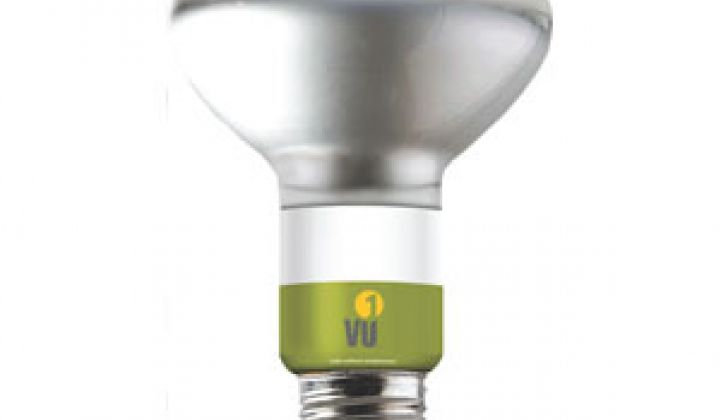The CRT TV is being reincarnated, sort of, as a light bulb.
Startup VU1 has come up with an energy-efficient flood light for homes that functions conceptually in the same way as that old TV tube in the basement. The bulb is more energy efficient than a TV, can light a room better than a set, and won't be used to paint images on walls, but the idea is essentially the same. An integrated electron source fires electrons at a phosphor-coated glass. The phosphor then gets excited and emits light.
Although like a TV tube, the architecture – which the company calls electron stimulated luminescence – differs substantially from other conventional or solid-state light sources on the market.
"It is not induction lighting. It is not plasma. It is not fluorescent. It is not halogen. It is not LED," said Ron Davis, the chief marketing officer. "It is a combination of three technologies we have merged over the last four and a half years."
Interestingly, another startup, Eden Park Illumination, has come up with a light that functions in a similar manner to a plasma TV.
VU1 has built prototypes and on Earth Day 2009, it hopes to start selling (at least in small numbers) a 17-watt bulb for recessed light cans found in kitchens and living rooms. The light bulb will emit 40 lumens per watt, or as much light as an incandescent 65-watt indoor flood light. The bulb, he added, will also cost about the same as the dimmable versions of the 65-watt bulbs that go into those fixtures now and will fit into those fixtures without a lot of fuss.
"It screws into a socket," he said.
The company raised $8 million a few years ago and just raised another $5 million to help it move into production.
The quality and the color of the light will also be similar to what consumers get with incandescent bulbs. It won't be that creepy, gray cast you remember seeing waking up at 3:00 a.m. after falling asleep watching reruns of "Hogan's Heroes." A single bulb lasts 6,000 hours, or longer than a regular incandescent but less than a florescent. The bulb emits heat, but only half as much as an incandescent.
Lighting is one of the central themes in the push by VCs into energy efficiency and green buildings. Lighting consumes around 22 percent of the electricity in the U.S. and a good portion of that power is wasted or used inefficiently. Over 90 percent of the power that goes into incandescent bulbs gets turned into heat rather than light. That's good if you want to power an Easy Bake Oven or cook up some Shrinky Dinks, but not if you want to light a room. (The incandescent was invented back in 1879).
Light startups that have received funding from VCs in recent years include Bridgelux (LEDs), Luxim (plasma lights), HID Labs (lighting controls) and Luminus Devices (LEDs).
Replacing old fashioned incandescent bulbs, though, has been tough because they are cheap. Consumers also like the warm tone of light.
Several companies have tried to revolutionize lighting and found it to be a long, tough slog, so VU1 has its work cut out for it. If anything, VU1 architecture seems to skirt some of the other problems that have hampered alternative light sources. Florescent bulbs emit light by exciting a gas with energy too. The gas in a florescent, however, is free floating inside the vacuum chamber of the bulb. The gas also happens to contain mercury. If a florescent cracks, mercury can get loose. VU1's bulbs do not contain mercury or other hazardous materials; the phosphorescent material is attached to the glass so no vapor can escape.
Meanwhile, VU1 says its bulb is cheaper than bulbs powered by LEDs. An indoor LED floodlight can cost around $90 to $130. Some manufacturers are trying to turn organic light emitting diodes (OLEDs), thin flexible sheets of material that light up, into light fixtures. The cost, however, remains high and work remains to make OLEDs more reliable.
The closest analogiy to VU1's bulbs are the plasma lights coming from Eden Park. Like VU1's Eden Park's lights convert excite a gas to emit light. Eden Park's lights also do not contain mercury. VU1's bulbs, arguably, have an advantage in that the phosphors are fixed to a glass and not floating in a vapor. Eden Park's lights are flat – an architect could cover a wall with 2" X 2" bulbs for an interesting design effect. VU1s look like regular lights.



